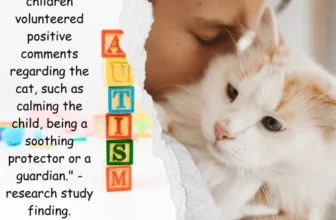Introduction

Bringing a new pet into your home is an exciting experience, especially if you have children. However, it’s important to ensure a safe and positive introduction between your California Spangled cat and your child. Failing to prepare could result in potential problems, such as aggressive behavior or allergies. In this guide, we’ll provide you with step-by-step tips on how to introduce your cat to your child safely, and how to build a lasting bond between them.
Why is it important to introduce your cat to your child?
| Introducing a California Spangled cat to your child is important for several reasons: |
| 1. Teaching kids to be responsible pet owners is crucial for their emotional development and wellbeing. By introducing your child to a cat, you’re teaching them how to take care of another living being and be accountable for their actions. |
| 2. California Spangled cats are very affectionate and make great companions, especially for children. Introducing your child to your cat will help them bond and develop a positive relationship. |
| 3. Teaching your child about cat behavior and how to respect their space and boundaries is important for both the cat’s and the child’s safety. By introducing them properly, you’re mitigating the risk of potential problems like aggressive behavior or scratches and bites. |
| 4. Involving your child in your cat’s care and playtime will not only strengthen their bond but also teach them valuable life skills and compassion towards animals. |
| 5. Finally, introducing your child to your California Spangled cat will provide them with a new and exciting source of entertainment. Cats are curious and playful creatures, which will keep your child occupied and engaged. |
Introducing your child to your California Spangled cat is important for their emotional, social, and cognitive development. It’s a great opportunity to teach them about responsibility, kindness, and respect for animals, while also providing them with a loving companion and a source of entertainment. By following the steps outlined in this article, you can ensure a safe and successful introduction for both your child and your cat.
Preparing for the introduction

Getting ready to introduce your California Spangled cat to your child is an important step in helping to create a safe and enjoyable environment for both your pet and your child. It’s essential to take the necessary precautions to ensure that your cat is comfortable and prepared for the introduction, while also teaching your child how to interact with the cat in a respectful and gentle manner. Before bringing your cat and child together, there are several key preparations you should make. To ensure a smooth and successful introduction, it’s important to understand what steps you need to take to set your child and cat up for success. For more information on how to safely introduce your cat to your child and build a strong bond between them, check out our article “Tips for parents- How to introduce your California Spangled cat to your child safely.”.
Get your cat ready
Getting your California Spangled cat ready for introduction to your child is essential for a successful and safe interaction. Here are a few tips to follow:
| Tip | Description |
|---|---|
| Schedule a vet visit | Before the introduction, make sure your California Spangled cat is up-to-date with all necessary vaccinations, and has a clean bill of health. This will ensure your child’s safety and help prevent any potential health risks. |
| Get grooming supplies | Cats are naturally clean animals, but ensuring that your California Spangled cat is clean and well-groomed before the introduction can help reduce any anxiety or stress. Purchase combs, brushes, and grooming wipes or shampoos for your cat’s health. |
| Create a safe space | Provide a separate space for your cat to retreat to if they feel overwhelmed or overstimulated. A cat tree or a separate room with a litter box, food, and water bowls can be an ideal space for your California Spangled cat to feel secure when needed. |
| Introduce smells | Although it may sound strange, it can be helpful to introduce your cat to your child’s scent before the actual meeting. Rub a piece of cloth or clothing on your child and leave it near your cat’s safe space. This way, your cat can get used to the scent and feel more comfortable in the presence of your child. |
By following these steps, you’ll be ensuring that your California Spangled cat is comfortable and ready to meet your child safely. It’s important to note that every cat is different, so it’s essential to monitor your California Spangled cat’s behavior closely during the introduction and make adjustments according to their emotional development. To learn more about the California Spangled cat breed and how to teach them behavior, check out our article on teaching your California Spangled cat behavior.
Prepare your child for the introduction
Before introducing your California Spangled cat to your child, it’s important to prepare your child for the interaction. Here are some important steps you can take to ensure that your child is ready for the introduction:
- Explain to your child what a cat is: If your child has never been around a cat before, it’s important to explain what a cat is, how it behaves, and what your child can expect from the interaction.
- Teach your child how to approach a cat: Children may not know how to approach a cat safely. Teach them not to pull on its tail or fur, or squeeze it too hard. Remind them to approach the cat slowly and gently, offering their hand to sniff first.
- Explain the importance of being calm: Cats can be sensitive to noise and commotion. Teach your child to approach the cat quietly, keeping their voice low and movements slow.
- Set expectations: Before introducing your California Spangled cat, set expectations for your child that this may take some time for the cat to warm up to them. Teach your child to be patient and respectful of the cat’s boundaries. This will also be an essential factor in raising California Spangled kids.
By preparing your child for the introduction, you can ensure that the interaction goes smoothly and safely. Additionally, in this process, your child can learn not only about cat behavior, but also how to interact with other animals in a respectful and considerate way. Ultimately, taking these steps can help to establish a positive and lasting bond between your California Spangled cat and your child, providing years of entertainment and learning opportunities.
Introducing your cat to your child

As a parent, introducing your California Spangled cat to your child may seem like a daunting task. However, it can be a wonderful experience for both your child and your cat. Before the introduction, it’s important to get your cat and child ready. Once you’ve prepared, it’s time to slowly introduce them to each other. In this section, we’ll discuss how to introduce your cat to your child safely and in a positive manner. By following these steps, you can help your child and cat establish a strong and loving bond.
Take it slow
Introducing a California Spangled cat to a child requires patience and a slow introduction process. It is important to let the cat set the pace and not force interactions before the cat is ready. Here are some steps to take to make the process as smooth as possible:
- Let the cat explore the new environment: Before introducing the cat to your child, allow it to get accustomed to its new home and surroundings. This can be done by setting up a comfortable area for the cat with food, water, litter box and toys.
- Gradually introduce scent: Cats rely heavily on their smell, and introducing a child’s scent before they can see them is an effective way to ease the cat’s anxiety. This can be done by letting the child play in an area and then bringing the cat into the room to sniff around while the child is not present.
- Keep introductions brief: When it’s time for the first meeting, keep it short and positive. Encourage the child to sit still and quietly while the cat approaches. If the cat seems interested, allow it to explore the child at its own pace.
- Repeat the process: After the initial introduction, continue to introduce the cat to the child in short and positive sessions. Gradually extend the length of the introductions until they become more comfortable with each other.
Taking things slow and allowing the cat to set the pace will make the introduction process a success in the long run. Both your child and the California Spangled cat will be able to develop a positive relationship that will last for years to come.
Supervise the interaction
When introducing your California Spangled cat to your child, it’s important to supervise their interaction to ensure both parties remain safe and comfortable. This is a crucial step as it helps your child understand the cat’s body language and behavior, and gradually learn how to approach and handle them responsibly.
Why is supervision important?
Cats, including California Spangled cats, can be temperamental and unpredictable, especially when faced with new situations or environments. A child’s sudden movements or loud noises may startle or frighten the cat, leading to aggressive behavior such as hissing, scratching or biting. Similarly, a child may not know how to handle the cat gently or may accidentally hurt them, leading to injuries or emotional distress. Supervision is the key to preventing such incidents and ensuring that the interaction between your cat and child is positive and enjoyable.
How to supervise the interaction
Supervising the interaction between your California Spangled cat and child involves being present and attentive at all times. Here are some tips to help you supervise safely and effectively:
| Tips | Explanation |
|---|---|
| Start with short sessions: | Allow your child and cat to spend short periods of time together, gradually increasing the length as they get more comfortable around each other. This helps your cat adjust to the child’s presence and prevents them from feeling overwhelmed or stressed. |
| Observe their body language: | Watch your cat’s body language closely during the interaction to see if they are showing any signs of distress, such as flattened ears, arched back or dilated pupils. Similarly, observe your child’s behavior and make sure they are not teasing or hurting the cat. |
| Intervene when necessary: | If you notice any signs of aggression or discomfort, intervene immediately by separating the cat and child, and redirecting their attention to a different activity. Be gentle but firm when doing this, and avoid shouting or punishing either party. |
| Teach your child: | Use the interaction as an opportunity to teach your child about cat behavior and body language. Explain what different gestures and sounds mean, and how to approach and handle the cat gently and respectfully. |
Conclusion
Supervising the interaction between your California Spangled cat and child is an important step in introducing them safely. By following these tips and being present and attentive, you can help your child develop a positive and loving relationship with their feline friend. For more ideas on how to encourage bonding between your California Spangled cat and child, read our article on California Spangled cat emotional development or how they entertain kids.
Teach your child to respect the cat
Part of Article: Teaching Your Child to Respect the Cat
A crucial part of introducing your California Spangled cat to your child is teaching them to respect the cat. Cats have boundaries and preferences, just like humans, and it’s essential to teach your child to approach and interact with the cat in a respectful manner. Here are some tips to help you teach your child to respect your cat:
| Tip #1: | Teach your child to approach the cat slowly and calmly. Sudden movements can scare cats and potentially lead to aggressive behavior or hiding. |
| Tip #2: | Show your child how to pet the cat gently. Teach them to start by stroking the cat’s back or chin and avoiding petting the cat’s belly or tail. |
| Tip #3: | Explain to your child that cats need their own space and may want to be left alone sometimes. Teach them to read the cat’s body language for signs of discomfort or frustration. |
| Tip #4: | Teach your child to never disturb the cat while it is eating, drinking, or using the litter box. These are essential activities for a cat’s health and well-being, and interference can cause stress and potential behavior problems. |
| Tip #5: | Remind your child to never pull the cat’s tail, ears, or whiskers. These sensitive areas can cause discomfort and pain for the cat and may lead to aggressive behavior or scratching. |
By teaching your child to respect the cat, you’re setting the foundation for a positive and healthy relationship between them. It’s crucial to establish these boundaries early on to ensure your cat feels safe and comfortable in their environment, and your child learns to interact with animals respectfully.
Building a bond between your child and your cat

Now that your child and California Spangled cat have been properly introduced, it’s time to build a bond between them. Encouraging a positive relationship between your child and cat can not only provide a great source of companionship, but it can also teach your child valuable lessons about empathy, responsibility, and nurturing. This section will provide some useful tips and guidelines for establishing a strong and loving bond between your child and feline friend. Let’s explore some creative and effective ways to ensure that this bond is built in a safe and fun environment.
Encourage gentle play
It’s important to encourage gentle play between your child and your California Spangled cat to build a positive relationship. Cats can become scared or aggressive if they feel threatened, so it’s crucial to teach your child how to interact with the cat in a respectful way. Here are some tips:
| Tip | Description |
| Provide appropriate toys | Provide toys such as soft balls or stuffed animals that are safe for your child to play with your cat. This will help your child learn how to play with the cat gently and avoid using their hands and feet as toys, which could result in scratches or bites. |
| Teach your child to pet gently | Show your child how to pet the cat gently on its back or chin. Avoid grabbing the cat’s tail, ears or feet as this can frighten or upset the cat. |
| Set rules | Set clear rules on what kind of play is acceptable with the cat, such as no chasing or grabbing. Enforce these rules consistently, which will help the cat feel secure and prevent negative interactions. |
| Supervise playtime | Always supervise playtime between your child and your cat. This will help you intervene if things get too rough and prevent any accidents from happening. |
Encouraging gentle play will help build a loving and affectionate bond between your child and your California Spangled cat. Remember, cats are sensitive animals and may need time to adjust to the presence of children. With patience and consistent positive interactions, your cat will learn to love and trust your child.
Involve your child in cat care
One way to build a strong bond between your child and your California Spangled cat is to involve them in the cat’s care. This not only teaches responsibility to your child but also strengthens their relationship with the cat. Here are some ways you can involve your child in caring for your feline friend:
- Feeding: Assign your child the responsibility of feeding your cat at designated times. Show them how much food to feed the cat and remind them not to overfeed.
- Grooming: Ask your child to help groom the cat by brushing its coat regularly. This not only keeps the cat’s coat healthy but also creates a bonding experience between your child and the cat.
- Clean-up: Your child should help in cleaning the litter box every day. Teach them how to scoop the litter and dispose of it properly. Also, show them how to wash and refill the litter box.
- Vet visits: Take your child with you when you take the cat to the vet for appointments. Teach your child about the importance of regular check-ups and the cat’s health needs.
Involving your child in your cat’s care not only helps strengthen their bond but also teaches them important life skills such as responsibility, empathy, and respect for animals. Plus, it makes your child feel like a valued member of the household.
Teach your child about cat behavior
Learning about cat behavior is an important part of introducing your California Spangled cat to your child safely. Here are some tips for teaching your child about cat behavior:
- Explain how to read body language: Cats communicate through their body language, and it’s important to teach your child how to interpret it. Explain the difference between a relaxed, friendly cat and an agitated, scared cat. Let your child know that a cat may hiss or growl if they want to be left alone, and that it’s important to respect their boundaries.
- Don’t pull the tail or ears: Children often don’t realize that pulling a cat’s tail or ears can be painful for the animal. Teach your child that it’s important to be gentle with the cat and not to pull on any part of their body. Encourage your child to stroke the cat’s head or back instead.
- Avoid staring into the cat’s eyes: Cats interpret direct eye contact as a sign of aggression or threat. Teach your child to avoid staring into the cat’s eyes directly, as this can scare them. Instead, encourage your child to look at the cat’s body language to figure out how they are feeling.
- Never hit or shake the cat: Physical violence against cats is never acceptable, and it’s important to teach your child this, too. Let your child know that hitting or shaking the cat can hurt or scare them, and it is never the right way to discipline them.
- Understand play behavior: Cats love to play, and it’s important for your child to understand what kind of play behavior is appropriate. Teach your child that it’s okay to play with a cat using a toy or scratching post, but that they should never use their own hands or feet to play with the cat, as this can encourage biting or scratching.
By teaching your child about cat behavior, you can help them understand the dos and don’ts of interacting with your California Spangled cat. This will not only keep your cat safe and happy, but will also help your child develop a lifelong love and respect for animals.
Managing potential problems
As much as we love our feline companions, we can’t always guarantee that everything will go smoothly when introducing them to our children. Sometimes, despite our best efforts, issues like allergies or aggressive behavior may crop up. But don’t fret. By being prepared and knowing how to handle these situations, you can help keep both your child and cat safe and happy. Let’s explore some tips for managing potential problems and what to do if they arise.
Handling allergies
Allergies can be a concern when introducing pets to children, especially if they have a history of allergies. California Spangled cats have short, fine fur, which may make them a good match for children who are allergic to other types of cats. However, it’s important to be prepared in case allergies do arise.
Here are some ways to handle allergies when introducing your California Spangled cat to your child:
| Step | Description |
|---|---|
| Step 1: | Consult with your child’s doctor to determine the best course of action. |
| Step 2: | Consider getting an air purifier with a HEPA filter to help remove allergens from the air. |
| Step 3: | Have your child wash their hands before and after handling the cat to help reduce allergen exposure. |
| Step 4: | Teach your child to avoid touching their face and eyes while handling the cat. |
| Step 5: | Keep the cat off of furniture and out of bedrooms to minimize allergen exposure. |
| Step 6: | If allergies persist, consider over-the-counter or prescription allergy medication under the guidance of a doctor. |
By taking these steps, you can minimize the risk of allergies interfering with your child’s bond with your California Spangled cat. Remember, it’s important to take allergies seriously and to consult with a doctor if necessary.
Addressing aggressive behavior
It’s not uncommon for cats to display aggressive behavior, especially when they feel threatened or uncomfortable. If your California Spangled cat shows signs of aggression towards your child, it’s important to address the issue promptly. Here are some steps you can take to address aggressive behavior:
- Identify triggers: The first step in addressing aggressive behavior is to identify what triggers your cat’s aggressive behavior. Does your cat get aggressive when your child touches their tail or ears? Or does your cat get territorial when your child enters a certain room? Once you identify the trigger, you can take steps to avoid those situations or modify your cat’s behavior.
- Redirect attention: When your cat starts to display aggressive behavior, it’s important to redirect their attention. You can use toys or treats to distract your cat and encourage them to play instead of becoming aggressive.
- Teach your child to recognize warning signs: In some cases, your cat’s aggressive behavior may be a defensive response to your child’s behavior. Teach your child to recognize warning signs like hissing or growling, and to give the cat space when they display those signs.
- Consult with a veterinarian: If your cat’s aggressive behavior persists despite your efforts to modify their behavior, it may be time to consult with a veterinarian. They can rule out any underlying medical issues that may be contributing to the behavior and provide guidance on how to address the issue.
Remember, aggressive behavior in cats is common but it’s important to address the issue to ensure the safety of both your child and your California Spangled cat. With patience and consistent effort, you can help your cat and child develop a positive relationship.
Dealing with scratches and bites
When introducing a cat to a child, it’s important to understand that scratches and bites may occur, even with the most well-behaved cat. It’s crucial to teach your child how to behave around a cat and to supervise their interaction, but accidents can still happen. Here are some tips for dealing with scratches and bites:
| Step | Action |
|---|---|
| 1 | If your cat scratches or bites your child, clean the wound immediately with soap and water. |
| 2 | Apply pressure to the wound with a clean towel to stop any bleeding. |
| 3 | If the wound is deep or your child is showing signs of an allergic reaction, seek medical attention right away. |
| 4 | If your cat bites your child, find out if your cat is up-to-date on vaccinations and seek advice from your vet on whether rabies treatment is necessary. |
| 5 | Teach your child to resist the urge to chase or tug on your cat’s tail, ears, or whiskers, as this can result in scratches or bites. |
| 6 | If your cat is showing signs of aggression, such as growling or hissing, separate your cat from your child and seek advice from your vet for potential behavior modification techniques. |
Remember, scratches and bites are a normal part of owning a cat, but it’s important to teach your child how to respect your cat’s boundaries and to supervise their interaction at all times. With proper education and care, scratches and bites can be minimized and a loving bond can be formed between your child and your California Spangled cat.
Conclusion
When introducing your California Spangled cat to your child, it’s essential to take the necessary precautions to ensure everyone’s safety and wellbeing. Remember, introducing your cat to a child and vice versa is a gradual process that requires patience, preparation, and supervision. As a parent, your main priority is to create a healthy and happy environment for your child and your pet.
Throughout the article, we’ve outlined several tips to help you prepare for the introduction, supervise the interaction, and build a bond between your child and your California Spangled cat.
It’s essential to keep in mind that every cat is different, and the introduction process may not be smooth sailing. However, you can avoid issues by taking the necessary steps and understanding your cat’s behavior and needs. Encourage a positive experience for both your child and your cat by teaching your kid to respect your pet’s boundaries and encouraging gentle play.
If you face any problems, such as allergies, aggressive behavior from your cat, or scratches and bites, don’t hesitate to seek help from a veterinarian.
Overall, introducing your California Spangled cat to your child can be a rewarding and heartwarming experience for all involved parties. By following our tips and tricks, you can ensure a smooth transition and a lifetime of happiness for your family and your feline friend.
Frequently Asked Questions
1. Can I introduce a California Spangled cat to my child?
Yes, with proper preparation and supervision, California Spangled cats can make wonderful pets for families with children.
2. What age is appropriate to introduce my child to a California Spangled cat?
It is best to wait until your child is at least six years old before introducing them to a California Spangled cat. This is because younger children may not have the maturity and understanding required to handle a pet responsibly.
3. How can I prepare my California Spangled cat for meeting my child?
Make sure your cat is up to date on all their vaccinations and has been spayed or neutered. Also, provide them with a comfortable space where they can retreat to if they feel overwhelmed.
4. Should I let my child pick up my California Spangled cat?
No, it is not a good idea to let your child pick up your California Spangled cat. This can be stressful for the cat and can even lead to injury if the cat becomes scared or agitated.
5. How long does it typically take for a California Spangled cat to acclimate to a child?
It varies for each cat, but it can take anywhere from a few hours to a few weeks for a California Spangled cat to adjust to a child’s presence.
6. What should I do if my child is allergic to my California Spangled cat?
If your child is allergic to your California Spangled cat, the best thing to do is to keep the cat out of your child’s bedroom and to use an air purifier to reduce the amount of pet hair and dander in the home.
7. How can I teach my child to respect my California Spangled cat?
Teach your child to approach the cat slowly and calmly, to avoid chasing or grabbing the cat, and to give the cat space when they need it. Also, encourage your child to use gentle touch when petting the cat, and to stop if the cat shows signs of discomfort or aggression.
8. What are some signs that my California Spangled cat is feeling stressed or uncomfortable around my child?
Some signs of stress in cats include hiding, hissing, growling, swishing the tail quickly, and flattening the ears against the head. If you notice any of these signs, it is best to separate your cat and child and to try again later.
9. Can I leave my child alone with my California Spangled cat?
No, it is not safe to leave your child alone with your California Spangled cat. Always supervise interactions between your child and cat to ensure safety for both.
10. What should I do if my California Spangled cat scratches or bites my child?
If your cat scratches or bites your child, wash the wound with soap and water and seek medical attention if necessary. Also, make sure to separate your cat and child and to reevaluate the situation to prevent future incidents.







